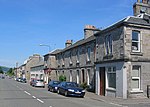Rosslyn Chapel, formerly known as the Collegiate Chapel of St Matthew, is a 15th-century chapel located in the village of Roslin, Midlothian, Scotland.
Rosslyn Chapel was founded on a small hill above Roslin Glen as a Catholic collegiate church (with between four and six ordained canons and two boy choristers) in the mid-15th century. The chapel was founded by William Sinclair, 1st Earl of Caithness of the Scoto-Norman Sinclair family. Rosslyn Chapel is the third Sinclair place of worship at Roslin, the first being in Roslin Castle and the second (whose crumbling buttresses can still be seen today) in what is now Roslin Cemetery.Sinclair founded the college to celebrate the Divine Office throughout the day and night, and also to celebrate Masses for all the faithful departed, including the deceased members of the Sinclair family. During this period, the rich heritage of plainsong (a single melodic line) or polyphony (vocal harmony) were used to enrich the singing of the liturgy. Sinclair provided an endowment to pay for the support of the priests and choristers in perpetuity. The priests also had parochial responsibilities.
After the Scottish Reformation (1560), Catholic worship in the chapel was brought to an end. The Sinclair family continued to be Catholics until the early 18th century. From that time, the chapel was closed to public worship until 1861. It was reopened as a place of worship according to the rites of the Scottish Episcopal Church, a member church of the Anglican Communion.
The chapel was the target of a terrorist bombing in 1914, when a suffragette bomb exploded inside the building during the suffragette bombing and arson campaign.
Since the late 1980s, the chapel has been the subject of speculative theories concerning a connection with the Knights Templar and the Holy Grail, and Freemasonry. It was prominently featured in this role in Dan Brown's bestselling novel The Da Vinci Code (2003) and its 2006 film adaptation. Medieval historians say these accounts have no basis in fact.
Rosslyn Chapel remains privately owned. The current owner is Peter St Clair-Erskine, 7th Earl of Rosslyn.








